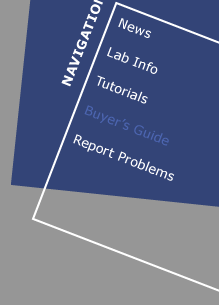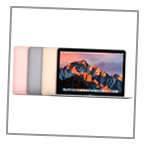
12" MacBook
At 11.04" W x 7.74" D x .14-.52" H & weighing in at just over 2lbs, the 12" MacBook is the smallest & lightest laptop Apple currently offers. Achieving that extreme portability, however, comes with some cutbacks in performance & features & at least a $225 higher price tag than the next most comparable offering, the highest end 13" MacBook Air. The 12" MacBook uses low-end Intel Core M processors at 1.1-1.3GHz. In benchmarks, the highest end 1.3GHz configuration is still slower than the 2.2GHz i7 available in the 13" MacBook Air. The integrated graphics card used in the Airs also outperform the one used in the MacBooks. Another drawback is the lack of ports - there's only one USB-C port on the MacBooks, used both for charging & peripheral connection (i.e. flash drives, portable hard drives, card readers, etc.), & a headphone jack. As most peripherals don't yet use USB-C, you'll most likely also need to purchase adapters to connect things up properly. For the extra $225, you instead get a higher resolution, sharper & brighter display & four casing colors to choose from with the MacBook.
We haven't purchased any 12" MacBooks in the Arts & don't have any plans to do so. Much like the MacBook Air when it was first introduced in 2008, the 12" MacBook is intended for light computer users with extra money to spare.
The 12" MacBook was last updated in April 2016.
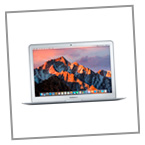
13" MacBook Air
While not quite as small, thin & light as the 12" MacBook, the 13" MacBook Air is still a highly portable laptop. It comes in at only about 1lb heavier, 1.76" wider, 1.2" deeper & .16" taller at it's thickest point. But, as mentioned in the 12" MacBook section, the 2.2GHz i7 Air configuration outperforms the highest end MacBook in both speed & graphics for less money. Plus, you'll get a dedicated MagSafe charging port, 2 USB 3.0 ports, a Thunderbolt 2 port, an SD card reader & a headphone jack. The lower-res display is about the only drawback.
While we've only purchased one 13" MacBook Air in the Arts, the Chancellor's Office has purchased a number for people across campus. For everyday internet browsing & basic Office functionality, the Air does a fine job, especially for the price. If, however, you're using the laptop for anything more strenuous, you'll want to look at one of the Pro models.
The MacBook Air was last updated in March 2015.
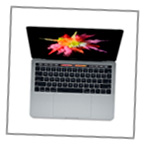
13" MacBook Pro with Touch Bar
After much anticipation & rumor, Apple finally introduced a revamped design for their MacBook Pros this last Fall. Borrowing design elements from the 12" MacBook, the MacBook Pros are smaller, thinner & lighter than ever before, even rivalling the Air with both 13" models. One of the biggest changes with the new MacBook Pros is the replacing of the top row of keys on the keyboard with a Touch Bar & Touch ID button. This integrated touch display changes buttons on-the-fly based on the current Application in use. The Touch ID portion of the Bar allows for login & online order verification via fingerprint. The biggest change, however, is with the built-in ports. All 2016 MacBook Pros now only offer USB-C/Thunderbolt 3 ports & a headphone jack. With the 13" MacBook Pro with Touch Bar, there are 4 USB-C/Thunderbolt 3 ports. They can be used for charging or with peripherals (i.e. external storage, displays, etc.), but will most likely require the purchase of additional adapters, as USB-C/Thunderbolt 3 isn't yet widely used. Other changes from previous generations of 13" MacBook Pros include a brighter display, clearer sounding speakers, larger trackpad, faster processor options, faster solid state drives, much better integrated Iris 550 graphics & a new keyboard design (which some reviewers have not liked as much). You can also now purchase the MacBook Pros in Silver or Space Gray. Unfortunately, all of these impovements do come with about a $320 price increase from the previous generation 13".
As the 13" MacBook Pro with Touch Bar is fairly new, we haven't purchased any of these models yet in the Arts. In fact, in the past we've usually shied away from the 13" model offerings altogether, mainly due to the poor performance of their integrated graphics. However, with this year's Iris 550 graphics & a similar price hike for the 15" models we usually buy, the 2.9GHz i5 13" MacBook Pro with Touch Bar might just become our new standard for most faculty/staff (the 2.9GHz i5 looks to offer the best performance-to-price ratio of the 13" offerings). If you want something portable that'll mainly be used for everyday internet browsing & Office work, but can also handle heavier work from time-to-time (like Photoshop, InDesign, Finale, etc.), the 13" MacBook Pro with Touch Bar should do the job. If, however, you'll primarily be working in design, CAD, 3D or video-editing applications, you'll want to seriously consider the 15" model with its discrete graphics options instead.
The 13" MacBook Pro was last updated in October 2016.
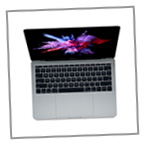
13" MacBook Pro without Touch Bar
Apparently, Apple wasn't so sure how their new Touch Bar models would go over with their customers & so opted to offer a new 13" MacBook Pro without Touch Bar as well. The main differences with the non-Touch version include a set of physical top row keys on the keyboard, only 2 USB-C/Thunderbolt 3 ports, somewhat poorer performing Iris 540 graphics, slightly slower integrated WiFi capabilities, slightly slower memory speed, one less built-in microphone & only 1 fan (which might mean a slighlty warmer laptop). The non-Touch battery, however, is a bit larger & might provide a little extra power for longer than on the Touch model. The non-Touch is available with either a 2.0GHz i5 or a 2.4GHz i7 processor. The i5 won't be quite as speedy as the low-end 2.9GHz i5 processor on the Touch model, but the i7 option should be almost on par with the Touch's 3.1GHz i5. Depending on the configuration, the 13" MacBook Pro without Touch Bar can end up being up to $270 cheaper.
Again, the new 2016 13" MacBook Pro without Touch Bar is too new for us to have purchased yet in the Arts. While it is a bit cheaper than the 13" Touch model, the additional ports, better graphics & other minor differences in specs, along with the potential of the Touch Bar, make the Touch model look like a bit better buy. However, if you simply prefer physical keys or have concerns about the Touch Bar's real world usefulness or the lifespan of it's display, then the 13" MacBook Pro without Touch Bar is probably for you. Otherwise, stick with the Touch model & particularly with the 15" model if you're working primarily in design, CAD, 3D or video-editing applications.
The 13" MacBook Pro was last updated in October 2016.
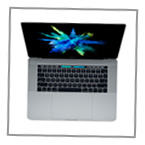
15" MacBook Pro with Touch Bar
As mentioned, Apple finally introduced revamped MacBook Pros this last Fall. Just like the new 13", the 15" MacBook Pro features a number of changes from previous generations. To begin with, it's slightly smaller, thinner & about .5lb lighter. Like the 13", it also comes with the new Touch Bar & Touch ID button, replacing the top row of keys on the keyboard with an ever-changing touch display & a way to log in & use Apple Pay online via fingerprint recognition. Unlike the 13", however, there's no non-Touch variant of the 15". The new 15" model also drops all old ports for only 4 USB-C/Thunderbolt 3 ports & a headphone jack. As with the 13" MacBook Pros, this will most likely require the purchase of adapters for existing peripherals to connect up properly. Other changes include a brighter display, clearer sounding speakers, faster solid state drives, much better discrete graphics card options, a much larger trackpad (even larger than on the new 13") & a new keyboard design (which might take some getting used to). You can also now purchase the MacBook Pros in Silver or Space Gray. When it comes to the new processor offerings, however, the new 15" i7 options come in slightly slower than last year's processors in benchmarks. In reported real world tests, though, the combo of faster solid state drives & better graphics cards seem to make up the difference & actually show a good overall performance gain (especially in 3D rendering & exporting video). Unforunately, as with the 13", the new 15" MacBook Pro with Touch Bar comes with a similar price hike from last year's model.
The 15" MacBook Pro with Touch Bar is too new for us to have purchased in the Arts yet. In the past, we've almost always purchased the 15" MacBook Pro for faculty wanting a portable Mac. However, with this year's considerable increase in price, we might rethink the 13" as our choice for most faculty, leaving the 15" for only those design & multimedia professors who really require the extra oomph of a discrete graphics card & quad-core i7 processor. If we do continue to go the 15" route for most faculty, we'll most likely stick to the low-end configuration. If you're a student in the Design or Multimedia programs who'll be using Adobe applications almost all the time, you'll definitely want to save up for a 15" MacBook Pro with Touch Bar. Really any of the configurations with the Radeon Pro 450 should suffice. If, however, you'll be working heavily in 3D, video or CAD, or can just afford it, the Radeon Pro 455 will give you a sizeable performance boost for a reasonable price.
The 15" MacBook Pro was last updated in October 2016.
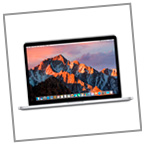
13" & 15" MacBook Pro (2015)
To further complicate your Mac laptop buying decision, Apple decided to continue selling select configurations of the previous generation 13" & 15" MacBook Pros. So, if you really don't like the Touch Bar, larger trackpad or new keyboard or, probably moreso, decry the loss of the MagSafe charging port, card reader & built-in HDMI, Thunderbolt 2 & USB 3.0 ports, you still have some, albeit dated, options. To be honest, the 2015 MacBook Pros should still do a good job for their intended purpose - everyday use with enough power to do minor work in applications like Photoshop, InDesign, Finale, etc. Make note, however, none of the 2015 models Apple still sells directly include a discrete graphics card, just the old, less powerful integrated Intel options, including on the 15". Benchmarks indicate a significant improvement in GPU performance with the integrated graphics in the 2016 13" models & the discrete graphics in the 2016 15" model will be a huge step up from the iGPU now standard in the 2015 15". If you hunt, though, you can still find a few resellers with leftover inventory of the 2015 15" models with the Radeon R9 M370X (like B&H), but only while supplies last. So, if you can afford it & don't mind all of the changes with the 2016 models, you're probably better off, performance-wise, sticking to any of the 13" & 15" MacBook Pro with Touch Bar models.
These MacBook Pro were originally introduced in May 2015.
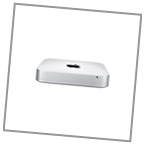
Mac Mini
At one time, the Mac Mini was a good option if you were strapped for cash; already had a monitor, keyboard & mouse; & didn't plan on doing any intensive 3D or video work. But, as Apple hasn't updated the Mac Mini now for over 2 years, it's harder to recommend it for even general use. An iMac is a much better option for the price, especially if you have to add in the cost of a new monitor, keyboard or mouse. In the Arts, we do have a handful of Mac Minis running as servers & they're pretty decent for that�definitely compact.
The Mac Mini was last updated in October 2014.
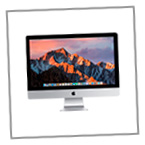
21.5" & 27" iMacs
An iMac is probably the best bang for your buck in the Apple desktop arena. Spec'd out with a quad-core i5 or i7 processor, most of the 27" iMacs are even faster than all but the highest-end, most expensive Mac Pros. Plus, everything comes in one nice package, so you don't have to add anything else into the cost (like a monitor). iMacs come in two screen sizes - 21.5" & 27". The 21.5" iMacs are available in two screen resolutions - 1920 x 1080 & 4K. The lower res model is further limited by a slower integrated graphics card & a 1.6GHz dual-core processor (though it can be upped to a 2.8GHz quad-core i5 with a slightly better iGPU). The 21.5" 4K models have higher res displays & an all quad-core selection of processors, but are stil somewhat hampered by their Intel Iris Pro 6200 integrated graphics. In benchmarks, the 6200 looks to be less powerful than the iGPUs on the 13" MacBook Pros without Touch Bar. The 27" iMacs all have 5K displays with various quad-core i5 & i7 options & four much more powerful discrete graphics cards to choose from. While any of the four AMD Radeon R9 graphics cards will be a giant leap in performance from the iGPUs on the 21.5" iMacs, the M390, M395 & M395X are the real standouts.
In the Arts, our Maclabs are almost entirely outfitted with fairly high-end 27" iMacs, years ago replacing the Mac Pros we used to use. We do have a few high-end 21.5" models in the Theatre Lab (mostly due to space limitations), though they're older models that actually came with discrete NVIDIA graphics cards. It's hard to recommend the 1.6GHz i5 1920 x 1080 21.5" iMac at all. The 2.8GHz i5 configuration of the same model would make it more useful, but for light duty only. The 4K 21.5" iMacs would allow for some minor Photoshop, InDesign, Finale, etc. work, but, right now, the 27" iMac models with their much more powerful discrete graphics cards are what most Design & Multimedia students should consider. If you can afford the $200 bump up to the M390 graphics, it's money well spent & if you'll be working heavily with 3D, CAD or video, you may want to look at the M395 or M395X.
The iMac was last updated in October 2015.
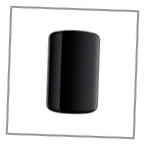
Mac Pro
If you can tolerate the hit to your bank account, the currently available highest-end Mac Pros are the desktop models to choose for intensive 3D, CAD & video work. These machines are just workhorses. They're 4, 6, 8 or 12-core Xeon E5 machines with dual FirePro graphics cards, speedy solid state storage, a wide variety of ports & room for lots of RAM. However, if you can't go 8 or 12-core on the Mac Pro with FirePro D500 or D700 graphics, the higher-end iMacs are just as powerful, at a much better price (especially since the Mac Pros haven't seen an update in a few years & also might incur the cost of a separate monitor). While we've mainly been using fairly high-end iMacs in the Arts in recent years, we do have a couple of these "trash can" Mac Pros for our heavier users & they work well.
The Mac Pro was last updated in June 2013.









